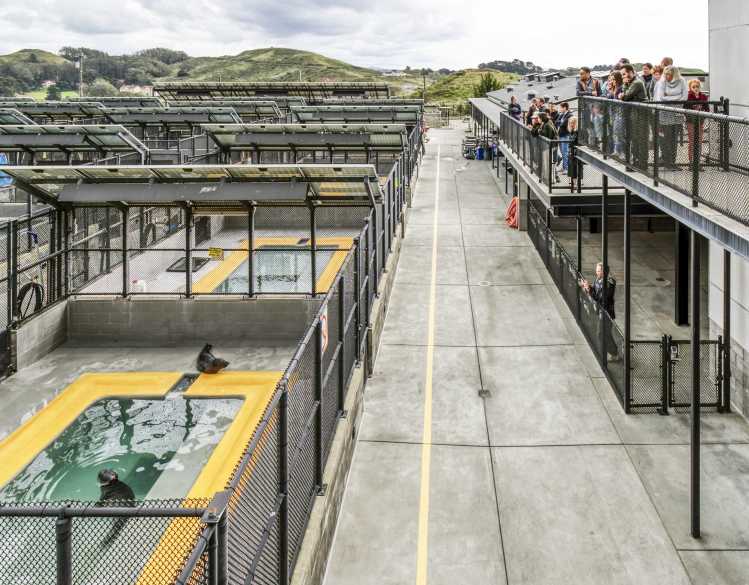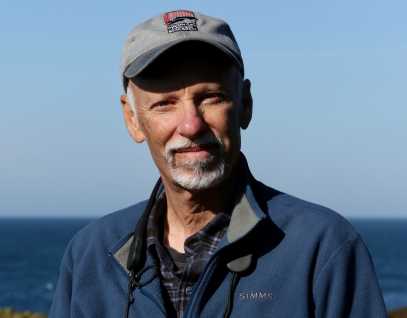
Harbor Porpoise Mating in the “Funnel of Love”
- Behavior
- Natural history
- Population monitoring
What Is the "Funnel of Love"?
Want to know the best place in the entire world to see harbor porpoises mating in the wild? Stand on the Golden Gate Bridge and look down! From 220 feet above the water, you will have an excellent vantage point and will not be interfering with the porpoises’ natural behaviors.
The bridge spans the narrow Golden Gate, a one-mile-wide strait separating the Pacific Ocean from the San Francisco Bay. As harbor porpoises pass between these two large bodies of water to feed, they are concentrated in the deep channel directly beneath the bridge. As the harbor porpoises swim by under the bridge (often in small groups of three to five at a time) mating attempts and other social activities increase dramatically. This area is affectionately known as the “Funnel of Love” by our experts.
Fortunately, almost all harbor porpoise mating occurs at or near the surface of the water, which makes it much more visible to the human eye. Harbor porpoise mating also occurs year-round, so our experts can study (and you can observe!) the mating patterns of harbor porpoises in any season.
For the best chance to view harbor porpoises in the wild, follow this guide:
- Time your visit to coincide with a high tide.
- Visit in the late morning when there are no bridge shadows interfering with your view.
- Make sure there is no fog and bring your binoculars for the clearest view.
- Drive, walk or ride to the bridge entrance on either the northern Marin County side or southern San Francisco side.
- Walk onto the pedestrian walkway facing east into the bay.
- Look between the two main towers toward the deepest part of the channel.
One of the best ways to spot harbor porpoises is by following bird activity. Gulls hover above active porpoise feeding areas, hoping to opportunistically feed on leftover fish. Keep an eye out for moving shadows and dorsal fins, as harbor porpoises can pop out of the water in an instant.

Next Stop: Sausalito
After you visit the Funnel of Love, head north of the bridge to The Marine Mammal Center.
You’ll hear inspiring stories of marine mammal survival, learn more about the inner workings of our hospital and find out how you can make a difference for animals like harbor porpoises.
Harbor Porpoise Mating
Harbor porpoises, like other cetaceans, mate in motion, but harbor porpoise mating is notably swift. As a female harbor porpoise surfaces for air and swims quickly along the surface of the water, a male may approach rapidly from below and initiate a mating attempt from the female’s left side.
Mating is very fast, occurring in just one to two seconds. The female will exert control over her mate selection by twisting her body to accept or reject the male’s attempt. In fact, it has been observed that 99 percent of mating attempts by males are not successful. When the pair do not connect during mating, the porpoises may rocket out of the water into the air.
Several unique adaptations may factor into this high-speed mating technique. Male harbor porpoises have exceptionally large testes, growing from golf ball-sized in the winter to football-sized in the summer mating season. Additionally, they possess a relatively large penis, up to a third of the length of their bodies. Both of these outsized adaptations are crucial for their reproductive strategy by helping produce a large quantity of sperm quickly and delivering it efficiently during rapid underwater mating.
Unlike many other mammals, the female harbor porpoise's vagina is not a straight tube. Instead, it is twisted and spiraled with flaps and folds that create barriers to impede the progress of sperm towards the cervix. This adaptation suggests that female harbor porpoises have evolved to exert more control over paternity, making it challenging for sperm to reach and fertilize their eggs.
Male harbor porpoise penises have adapted to twist to the left, thought to aid in proper positioning during mating by ensuring the correct insertion into the female's vagina, which increases the chances of successful fertilization.
In contrast to many mammals, including other cetaceans, where males are larger and engage in physical competition for mating rights, harbor porpoise males are smaller than females and do not engage in physical fights with other males. Instead, their competition primarily occurs within the female's reproductive tract, where multiple males' sperm may engage in a "sperm competition” to reach and fertilize the egg first.
Harbor porpoises are thought to become sexually reproductive at three to four years of age. In California, calves are born in June or July after a 10.5-month gestational period, and they will nurse and stay close to the mother for roughly nine months. Research indicates that males and females are not strongly bonded, and every adult harbor porpoise may have multiple mates every year. Harbor porpoises often reproduce year after year, with a much shorter interval between pregnancies than other cetaceans.
Harbor Porpoise Research at The Marine Mammal Center
Harbor porpoises have returned to San Francisco Bay after an absence of approximately 65 years. The Center's Cetacean Field Research Team is conducting a multi-year assessment to document this population’s abundance and distribution, as well as to examine their social behavior and calving success.
{"image":"\/Animals\/Wild\/Harbor porpoise\/cropped-images\/two-harbor-porpoises-203-2-599-467-1705601520.jpg","alt":"two harbor porpoises mating","title":"Sexual Behavior and Anatomy in Porpoises","link_url":"https:\/\/www.marinemammalcenter.org\/publications\/sexual-behavior-and-anatomy-in-porpoises","label":"Research Paper","type":"publication"}

{"image":"\/Animals\/Wild\/Harbor porpoise\/cropped-images\/harbor-porpoises-aerial-view-badge-by-marc-webber-c-the-marine-mammal-center-0-88-1280-999-1618509985.jpg","alt":"Harbor porpoises seen from above","title":"Coevolution of Asymmetric and Spiraled Genitalia with Unique Mating Behavior","link_url":"https:\/\/www.marinemammalcenter.org\/publications\/coevolution-of-asymmetric-and-spiraled-genitalia-with-unique-mating-behavior","label":"Research Paper","type":"publication"}

Coevolution of Asymmetric and Spiraled Genitalia with Unique Mating Behavior
Read More{"image":"\/Animals\/Wild\/Harbor porpoise\/harbor-porpoise-shutterstock-2.jpg","alt":"harbor porpoise","title":"Harbor Porpoises Catching and Handling Large Fish","link_url":"https:\/\/www.marinemammalcenter.org\/publications\/harbor-porpoises-catching-and-handling-large-fish","label":"Research Paper","type":"publication"}

{"image":"\/Animals\/Wild\/Harbor porpoise\/cropped-images\/harbor-porpoise-by-bill-keener-c-the-marine-mammal-center-309-73-1207-943-1610670087.jpg","alt":"Harbor porpoise surfacing in the water","title":"The Sex Life of Harbor Porpoises: Lateralized and Aerial Behavior","link_url":"https:\/\/www.marinemammalcenter.org\/publications\/the-sex-life-of-harbor-porpoises-lateralized-and-aerial-behavior","label":"Research Paper","type":"publication"}

The Return of Harbor Porpoises
The harbor porpoise is found in the cold, coastal waters of the northern hemisphere, and in northern California, harbor porpoises can be seen year-round. In fact, our researchers consistently spot these animals swimming inside the San Francisco Bay – and you can, too!
But it wasn’t always so; while harbor porpoises were frequently seen in San Francisco Bay until the 1940s, they disappeared for almost 60 years. It is believed that harbor porpoises relocated during that time due to the use of anti-submarine nets in World War II and an increase in environmental contaminants from industrialization.
In the 2000s, following decades of water quality and habitat improvement that led to healthier fish populations, harbor porpoises began to reappear in San Francisco Bay. Today, harbor porpoises are present in the Bay 365 days a year, and our experts conduct population surveys to understand this critical habitat.
How You Can Help
While harbor porpoise populations have rebounded dramatically in the last few decades, there are still threats to these animals in their California habitat. The San Francisco Bay is one of the busiest waterways for ship traffic in the world. Entanglement in commercial fishing gear, underwater noise pollution and runoff containing environmental contaminants are still unfortunate realities threatening harbor porpoises in our coastal waters.
We are working with local agencies, the fishing and shipping community, and people like you to help preserve critical habitat for harbor porpoises.
The Marine Mammal Center responds to stranded animals along the California coast from San Luis Obispo to Mendocino. If you see a sick or injured harbor porpoise, please call our hotline: 415-289-7325 (SEAL). Our trained teams respond to marine mammals in need. Our life-saving rescues are made possible with the support of people like you.
Yes, I want to save a life!

Yes, I want to save a life!
You’ll be giving sick and injured animals the best possible care at the Center’s state-of-the-art hospital. With your gift today, you are giving a patient a second chance at life in the wild.
See Our Latest News
{"image":"\/Animals\/Patients\/Elephant seals\/2025\/cropped-images\/elefante-es-photo-by-bill-hunnewell-104-0-1270-992-1767832647.jpg","alt":"Elefante \u2013 Northern elephant seal","title":"Rescue Stories: Vote for Your Favorite Marine Mammal Patient of 2025!","link_url":"https:\/\/www.marinemammalcenter.org\/news\/rescue-stories-vote-for-your-favorite-marine-mammal-patient-of-2025","label":"News Update","date":"2026-01-16 10:05:08"}

Rescue Stories: Vote for Your Favorite Marine Mammal Patient of 2025!
January 16, 2026
Read More{"image":"\/People\/Action\/Veterinary care\/cropped-images\/Harris_Green turtle_TMMC-0-0-1270-992-1767649941.jpg","alt":"Heather Harris","title":"Seattle Aquarium Awards Dr. Heather Harris With Prestigious Conservation Research Award","link_url":"https:\/\/www.marinemammalcenter.org\/news\/seattle-aquarium-awards-dr-heather-harris-with-prestigious-conservation-research-award","label":"In the News","date":"2026-01-05 04:48:00"}

Seattle Aquarium Awards Dr. Heather Harris With Prestigious Conservation Research Award
January 5, 2026
Read More{"image":"\/People\/Action\/Veterinary care\/cropped-images\/harris-teaching-tube-feeding-0-0-1270-992-1767650122.jpg","alt":"A veterinarian and two trained volunteers tube feed an elephant seal pup.","title":"Training College Students in Marine Mammal Health","link_url":"https:\/\/www.marinemammalcenter.org\/news\/training-college-students-in-marine-mammal-health","label":"News Update","date":"2026-01-05 04:48:00"}

{"image":"\/Animals\/Patients\/Harbor seals\/2013\/cropped-images\/hs-bogey-photo-by-Ingrid-Overgard-c-the-marine-mammal-center-382-0-2914-2276-1605061447.jpg","alt":"harbor seal Bogey","title":"Top Eco Friendly Valentine\u2019s Day Gifts","link_url":"https:\/\/www.marinemammalcenter.org\/news\/top-eco-friendly-valentines-day-gifts","label":"News Update","date":"2026-01-01 01:00:00"}







